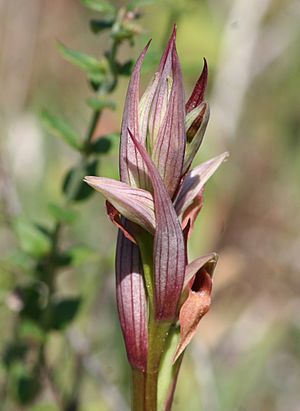Small-flowered tongue-orchid facts for kids
Quick facts for kids Small-flowered tongue-orchid |
|
|---|---|
 |
|
| Inflorescence of Serapias parviflora | |
| Scientific classification | |
| Genus: |
Serapias
|
| Species: |
parviflora
|
| Synonyms | |
|
|
Imagine a beautiful, small flower that looks a bit like a tongue! That's the Serapias parviflora, also known as the small-flowered tongue-orchid. This special plant is a type of orchid. It grows naturally around the Mediterranean Sea and along the Atlantic coast of Europe.
Contents
What Does the Small-Flowered Tongue-Orchid Look Like?
The Serapias parviflora is a relatively small plant. It usually grows to be about 10 to 30 centimeters (around 4 to 12 inches) tall. Sometimes, it can even reach up to 40 centimeters (about 16 inches).
Leaves and Stem
At the bottom of its stem, this orchid has 4 to 7 long, narrow leaves. These leaves have a raised ridge, like the keel of a boat. Higher up the stem, you might find 1 to 3 smaller leaves that look more like bracts (small, leaf-like structures near flowers).
Flowers and Their Shape
The flowers of the Serapias parviflora grow in a group called a spike. There are usually 3 to 8 flowers in each spike, but sometimes there can be up to 12. The flowers have a unique look. Their sepals and petals (which are like the flower's outer leaves) are a grayish-pink color. They form a kind of hood over the center of the flower.
Underneath this hood, you'll find the flower's "lip" (also called the labellum). This lip is typically about 14 to 19 millimeters (around 0.5 to 0.75 inches) long. It's this part that gives the orchid its "tongue-orchid" name!
Where Does This Orchid Grow?
The small-flowered tongue-orchid is found in many places. Its main home is around the Mediterranean Basin. This area stretches from the Iberian Peninsula (where Spain and Portugal are) all the way to the Aegean Sea (near Greece and Turkey).
Atlantic Coast and Islands
You can also find this orchid growing in the Canary Islands. These islands are off the coast of Africa in the Atlantic Ocean. It also grows along the Atlantic coast of France.
Discovery in the United Kingdom
In 1989, something exciting happened! The Serapias parviflora was discovered at Rame Head in Cornwall, which is in the United Kingdom. Scientists think it might have spread there naturally, perhaps carried by wind or birds.
See also
 In Spanish: Serapias de flor pequeña para niños
In Spanish: Serapias de flor pequeña para niños

